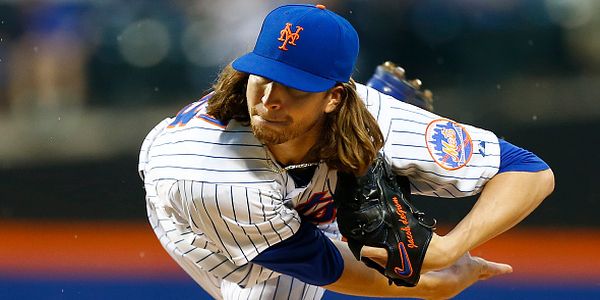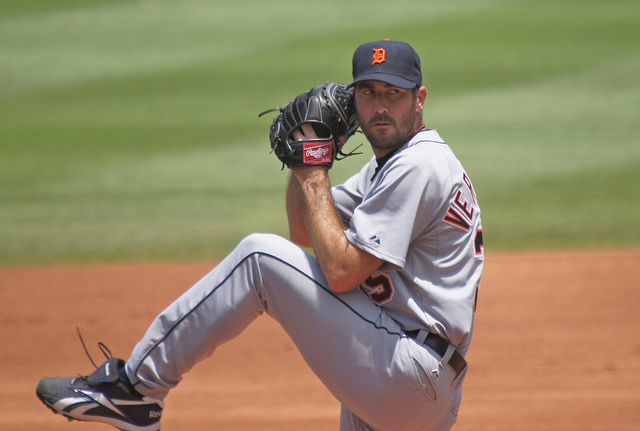All Aboard The Cole Train
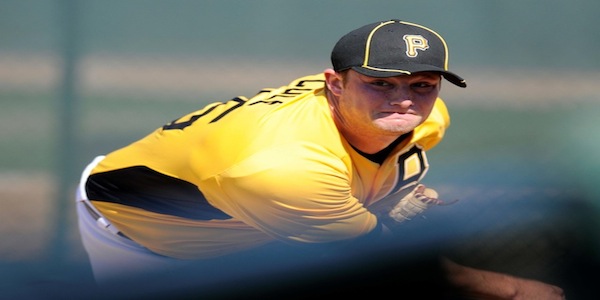
Gerrit Cole has been on prospect radars for years. He’s been there for good reason; near triple digit heat, huge frame, and good off-speed stuff. He finally arrived in Pittsburgh this year and the results have been extremely positive. As of today, Mr. Cole has a 3.23 ERA. His peripherals paint an even prettier picture, albeit slight, with a 2.98 FIP and 3.18 xFIP. To put that in Layman’s terms: he hasn’t been lucky, just very good.
The knock on Cole, if there was a legitimate one, was that his stuff sometimes played down in the eyes of scouts. He wasn’t as dominant as you would expect with the arsenal he possesses. I realize that may sound somewhat stupid after seeing his ERA & FIP in the paragraph above, but Cole wasn’t missing as many bats as nearly everyone, including myself, thought he should. Cole’s K% by month since his call up are as follows: 10.9%, 21.3%, 19.8%, and 27.6%. He went from striking out nearly no one in June to striking out a ton of batters so far in September. June is looking more and more like a fluke, especially when you consider his minor league track record. However, in AAA this season though his numbers didn’t jump off of the page. Cole was only striking out 6.22 batters per nine before his call up. Scouts began to wonder what could possibly be the cause for such electric stuff to be hit so often. The past few times Cole has taken the mound he’s looked like an entirely different pitcher. The results have altered his real life value and his fantasy value.
Pitching To Contact
It’s long been a theory in pitching that pitching to contact can achieve many things. It can lower walks, save pitches, and allow pitchers to deeper into games. Cole was pitching into a ton of contact, whether he was doing it on purpose or not. You might be asking yourself why he wouldn’t be trying for strikeouts. There are a few possible explanations, but I want to focus on two in particular. Through Cole’s first 18 starts in the major leagues he has a 49% ground ball rate. That’s a pretty solid number. For all pitchers with at least 100 IP so far in 2013, Cole GB% ranks 39th. It’s not exactly elite, but it’s a very solid spot to be. His HR/FB rate comes in at 37th; not elite, but good. It’s a good recipe. Guys that get a good amount of grounders don’t mind allowing a few more balls in play for one huge reason: balls hit on the ground can’t leave the yard.
The second thing I want to focus on is the Pittsburgh Pirates’ outstanding defense. Tons of smart people have written many fantastic pieces on how well the Pirates’ defense has played in 2013, but this is my favorite one. The Pirates underwent a systematic change in their approach after their late season fade in 2012. Led by GM Neil Huntington, the Pirates began to embrace sabermetrics perhaps more than any other team in the major leagues. The results are stunning.

*Numbers pulled from piece linked above. * denotes ongoing performance*
The Pirates’ new approach has paid major dividends so far. They’re one of the most impressive defensive teams in the major leagues. As of September 19, their numbers have changed a little. They now sit a 61 DRS, good for 3rd in the majors. The part that pertains mostly to Cole is the GB%. We can now see perhaps why he was pitching to contact so much; it’s a franchise teaching. A mindset passed down from the front office. It’s worked for the team, it should work for Cole too right? Well right, but Cole has a lot more ability than guys like Charlie Morton and Wandy Rodriguez.
More K’s Please
September is a small sample size, but the changes in Cole’s approach to pitching has seemingly altered immensely since the end of August. Let’s dive in.
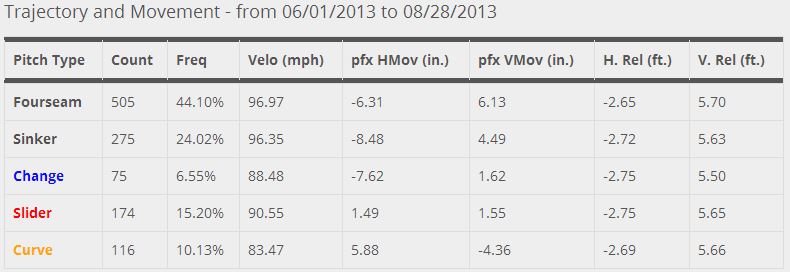
As you can see Mr. Cole was extremely fastball happy during his first few months in the big leagues. His usage of his 4-seam and sinker made up a little over 68% of the pitches he threw. The MPH on his average fastball is the third best in the majors, so I can’t really blame him. Despite his extreme use of his fastballs ,the results weren’t bad by any means, but they weren’t outstanding either. Cole compiled a 3.81 ERA over his first 13 starts. That’s adequate for a rookie getting his first taste of the big leagues, but where were the strikeouts? Only 18.38% of the batters Cole faced during this time period were forced to head back to the dugout with the shame of a strikeout. Cole was getting plenty of whiffs on his pitches, but his k’s were still down.
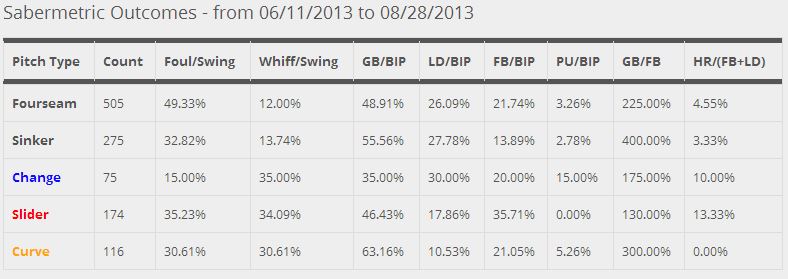
Cole was getting a very good amount of whiffs on his off-speed stuff, but hitters very seldomly swung and missed at either variation of his fastball. They didn’t do much with it except for beat it into the ground, but at 96 MPH it’s not crazy to think there would be more whiffs on those pitches.
Gerrit Cole was absolutely filthy today. He struck out 12 batters in 6 innings. He was pumpng 98 MPH heat in his last frame. He’s actually been absolutely filthy for a few weeks now, but I wanted to let the sample size of the following information get a little larger before drawing any conclusions. Cole’s improved usage of his pitches are a huge factor in his newfound dominance.

Cole is utilizing his off-speed pitches much more in his 5 most recent starts. He’s still throwing either variation of his fastball nearly 60% of the time, but he’s still much more balanced. As you would expect, he throws the slider more frequently versus RHH and uses his curve and change-up more versus LHH. The whiff chart was a little different than I was expecting.
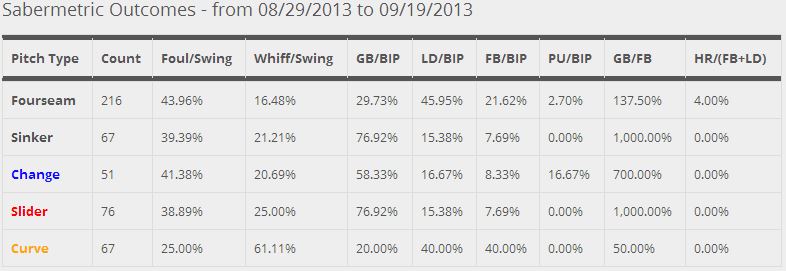
He’s getting more whiffs on three pitches (4-seam,sinker, and curve) and less whiffs on 2 pitches (change & slider). I should have expected the rates would go down on a few pitches due to the fact that hitters seeing the pitches more allows for more looks and video to study their movements and tendencies. That 61.11% whiff rate on the curve is probably unsustainable, but even if it comes back to Earth, we’re still looking at an elite whiff rate.
The results from our findings in pure strikeout percentage?

The change has been phenomenal. He’s striking out a hugely significant amount of batters. That’s an elite amount of strikeouts. If this is the real Gerrit Cole, then dear lord.
Location is also a huge deal for Cole. He gets ground balls at a very solid rate, so it wasn’t surprising to see how often he pitched down in the zone, but I came away from this with a little more of an appreciation at his ability to consistently keep the ball down. I wasn’t forced to split the data as I had to above, because his location plots haven’t changed very much throughout the year.
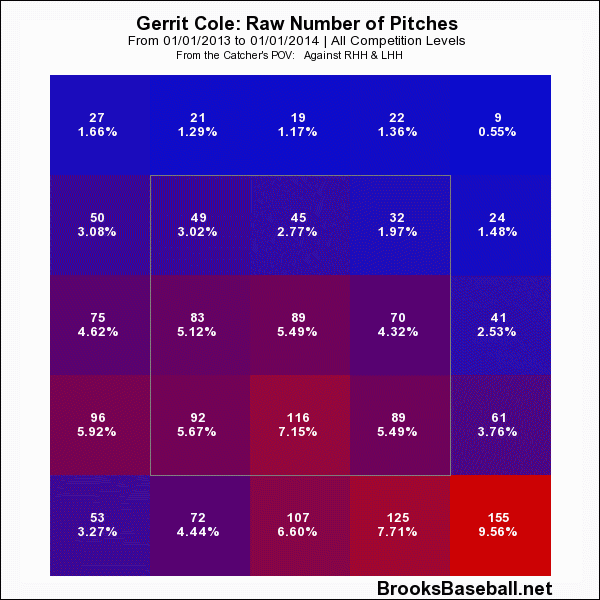
Gerrit Cole doesn’t miss up in the zone. He throws a bowling ball sinker at 95+ MPH while mixing in extremely effective secondary offerings, such as his curveball which flashes tremendous depth and is quickly out of the zone.
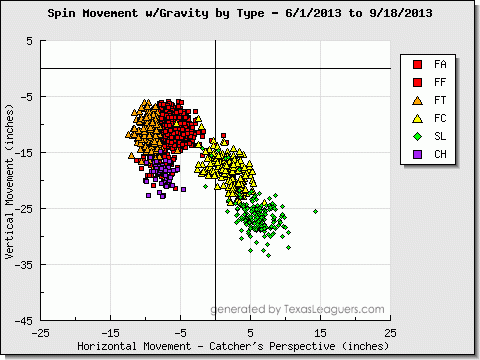
I’ve used pitch f/x charts before in order to help visualize pitches from the catcher’s perspective. As always, there can be a few pitch clarification errors at times. Cole’s curve ball velocity is the 2nd highest in the majors, so that could lead to curves being qualified as sliders (SL) and lead sliders to be qualified as cutters (FC) in the illustration above. Focus on the movement though, as with Anibal Sanchez. Cole has a solid array of pitches that offer many different types of movement. It’s not hard to understand why his curve generates so many whiffs when you look at how much it moves.
Comps For Future Performance
I’ve taken the 2013 pitching leaderboard at FanGraphs and set some parameters to look at possible comps for Mr. Cole and his newfound approach. It is as follows:

I’ve highlighted K%-BB% and GB% to shed light on those categories. The main reason for that is the fact that those are two of the most important stats for pitcher’s in my opinion. The pitchers on this list are all very solid to phenomenal pitchers. Cole probably has as much or more natural talent than half of them.
The name that I thought was most comparable to Cole at first glance was Matt Harvey. Obviously, I’m not saying Cole could be as good as Harvey because Harvey was absolutely unreal in 2013. Just for fun, let’s compare their lines and pitch mixes. For Matt Harvey we’ll use all of 2013; for Cole we’ll use his last 5 starts (small sample size alert).

Harvey’s much more comfortable throwing his change-up to righties than Cole is, although Cole has seemingly become more comfortable as his feet have gotten a little wetter. The comparison to their approach to RHH is definitely not perfect, but aside from the edge Harvey has in deploying his change-up Cole’s current approach isn’t as far off as it used to be.

LHH are a different story. Harvey throws either variation of his fastball 59.2% of the time. Cole uses his 53.4% of the time. Their change-up use is virtually identical. Their slider usage is very similar. Cole does use his curve more frequently, but over the time frame he’s used it 20.1% of the time it has a 60% whiff rate so it’s tough to argue there. The new and improved Cole does look eerily similar to Harvey. Harvey’s 2013 K%-BB% sits at 23.2%. Cole’s last five starts, as stated above, put him at 21.9%. Nice company.
Obviously the Harvey comp isn’t perfect, but that part of the piece was just for fun. They do have some similarities, but it’s clear the each have their own tendencies that they favor at the moment.
Cole’s value going forward has taken a tremendous leap forward with his ability to miss major league bats. If he’s healthy and these changes are sustainable over a longer period of time, as of now I see no reason why they can’t be, then we could be looking at a bonafide fantasy ace. At the very least, I have no problem projecting him as a #2 option going into 2014 if he finishes the season strong. Let’s keep the Harvey comparison going for just one more exercise. Harvey’s o-rank on Yahoo before the 2013 season was 135. If Cole finishes strong, I doubt he’ll be ranked that low, but if he is anywhere near that? Sign me up.
Choo Choo.



